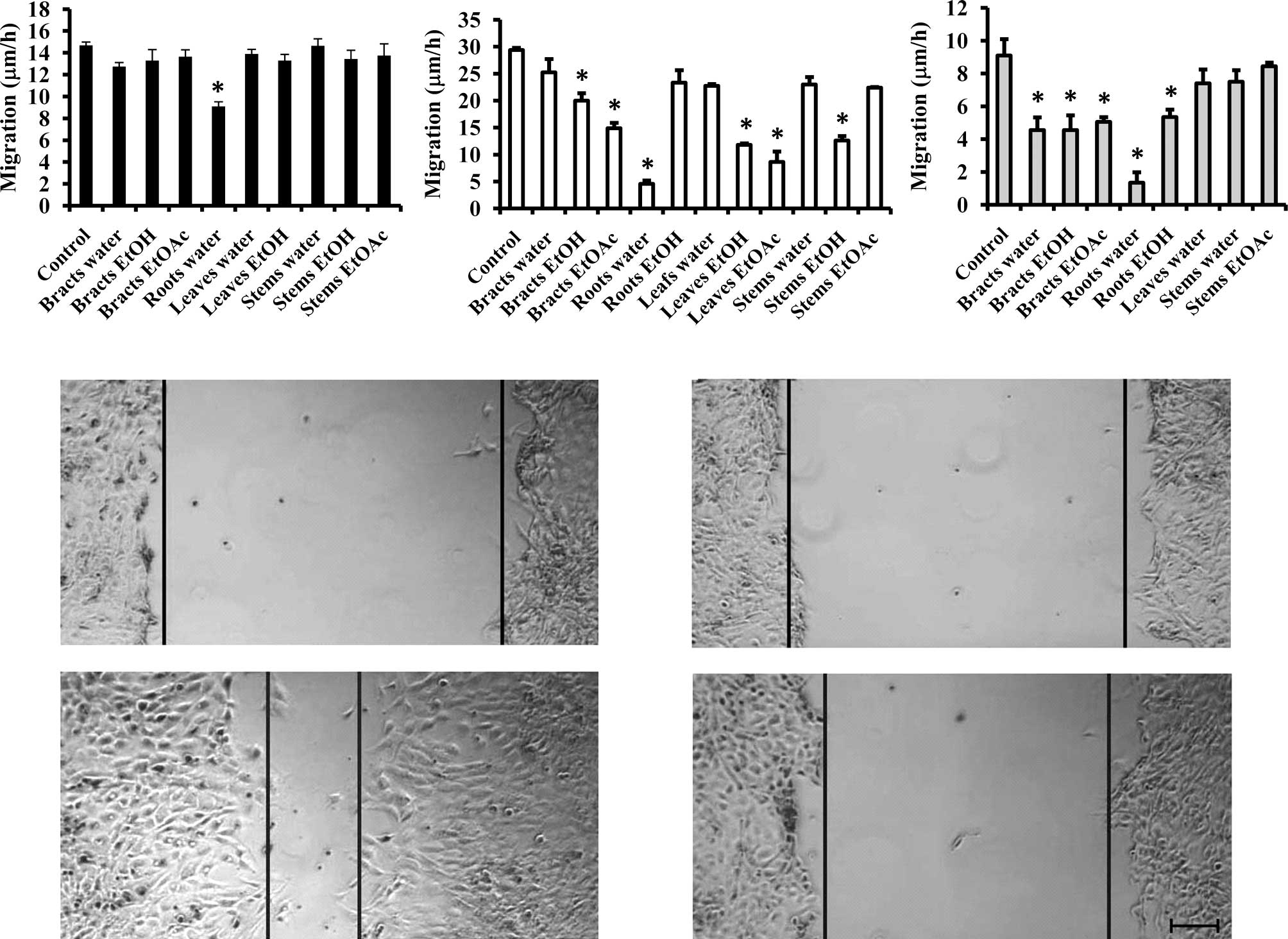In vitro anticancer activity of Anemopsis californica
- Authors:
- Catherine N. Kaminski
- Seth L. Ferrey
- Timothy Lowrey
- Leo Guerra
- Severine van Slambrouck
- Wim F.A. Steelant
-
View Affiliations
Affiliations: Laboratory of Biochemical and Biomedical Research, Department of Chemistry, New Mexico Tech, Socorro, NM 87801, USA
- Published online on: July 1, 2010 https://doi.org/10.3892/ol_00000124
-
Pages:
711-715
Metrics:
Total
Views: 0 (Spandidos Publications: | PMC Statistics:
)
Metrics:
Total PDF Downloads: 0 (Spandidos Publications: | PMC Statistics:
)
This article is mentioned in:
Abstract
Three different extract conditions (aqueous, EtOH and EtOAc) of four different parts (bracts, leaves, roots and stems) of the plant Anemopsis californica (A. californica) were evaluated for their effect on the growth and migration of human colon cancer cells, HCT-8, and the breast cancer cell lines Hs 578T and MCF-7/AZ. Our aim was to identify potential anticancer activity in crude A. californica extracts, given that this plant is used by Native Americans to treat a variety of diseases, including cancer. Our results demonstrated that for each of the cell lines tested, the majority of ethyl acetate extracts of all the plant parts are more toxic than the aqueous and ethanol extracts. Furthermore, significant growth inhibitory activity against the three cell lines was found for the ethyl acetate extract of the roots, while the aqueous extract of the roots influenced the migratory capacity of the three cell lines. This study provides evidence for the anticancer properties of A. californica when extracted in water and ethyl acetate, and supports the importance for further purification of the crude extracts and isolation of potential new anticancer compounds through bio-guided fractionation.
View References
|
1
|
Cragg GM, Grothaus PG and Newman DJ:
Impact of natural products on developing new anti-cancer agents.
Chem Rev. 109:3012–3043. 2009. View Article : Google Scholar : PubMed/NCBI
|
|
2
|
Cragg GM and Newman DJ: Plants as a source
of anti-cancer agents. J Ethnopharmacol. 100:72–77. 2005.PubMed/NCBI
|
|
3
|
Moerman DE: Native American Ethnobotany.
5th edition. Timber Press; pp. 11–13. 1998
|
|
4
|
Childs RF and Cole JR: Phytochemical and
pharmacological investigation of Anemopsis californica. J
Pharm Sciences. 54:789–791. 1965. View Article : Google Scholar
|
|
5
|
Medina-Holguin AL, Holguin FO, Micheletto
S, Goehle S, Simon JA and O’Connel MA: Chemotypic variation of
essential oils in the medicinal plant, Anemopsis
californica. Phytochemistry. 69:919–927. 2008. View Article : Google Scholar : PubMed/NCBI
|
|
6
|
Daniels AL, van Slambrouck S, Lee RK,
Arguello TS, Browning J, Pullin MJ, Kornienko A and Steelant WF:
Effects of extracts from two Native American plants on
proliferation of human breast and colon cancer cell lines in
vitro. Oncol Rep. 15:1327–1331. 2006.PubMed/NCBI
|
|
7
|
Romijn JC, Verkoelen CF and Schroeder FH:
Application of the MTT-assay to human prostate cancer cell lines in
vitro: establishment of test conditions and assessment of
hormone-stimulated growth and drug-induced cytostatic and cytotoxic
effects. Prostate. 12:99–110. 1988. View Article : Google Scholar
|
|
8
|
Skehan P, Stroeng R, Scudiero D, Monks A,
McMahon J, Vistica D, Warren JT, Bokesch H, Kenney S and Boyd MR:
New colorimetric cytotoxicity assay for anticancer drug screening.
J Natl Cancer Inst. 82:1107–1112. 1990. View Article : Google Scholar : PubMed/NCBI
|
|
9
|
Van Slambrouck S, Hilkens J, Bisoffi M and
Steelant WFA: AsialoGM1 and integrin α2β1 mediate prostate cancer
progression. Int J Oncol. 35:693–699. 2009.
|
|
10
|
WHO guidelines on good agricultural and
collection practices (GAPC) for medicinal plants. World Health
Organization. Geneva: 2003.
|
|
11
|
Mareel M and Leroy A: Clinical, cellular
and molecular aspects of cancer invasion. Physiol Rev. 83:337–376.
2003. View Article : Google Scholar
|
|
12
|
Horton WJ and Paul EG: 4-Allylveratrole
from Anemopsis californica. J Am Chem Soc. 79:2264–2266.
1957. View Article : Google Scholar
|
|
13
|
Acharya RN and Chaubal MG: Essential oil
of Anemopsis californica. J Pharm Sciences. 57:1020–1022.
1968. View Article : Google Scholar
|
|
14
|
Sanvordeker DR and Chaubal MG: Essential
oil of Anemopsis californica Part II: minor constituents. J
Pharm Sciences. 58:1213–1217. 1969.
|
|
15
|
Tutupalli LV and Chaubal MG: Composition
of essential oil from foliage of Houttuynia cordate and
chemosystematics of Saururaceae. Lloydia. 38:92–96. 1975.PubMed/NCBI
|
|
16
|
Ogasawara M, Matsubara T and Suzuki H:
Screening of natural compounds for inhibitory activity on colon
cancer cell migration. Biol Pharm Bull. 24:720–723. 2001.
View Article : Google Scholar : PubMed/NCBI
|
|
17
|
Lee SJ, Lee KW, Hur HJ, Chun JY, Kim SY
and Lee HJ: Phenolic phytochemicals derived from red pine (Pinus
densiflora) inhibit the invasion and migration of SK-Hep-1
human hepatocellular carcinoma cells. Ann NY Acad Sci.
1095:536–544. 2007.PubMed/NCBI
|











